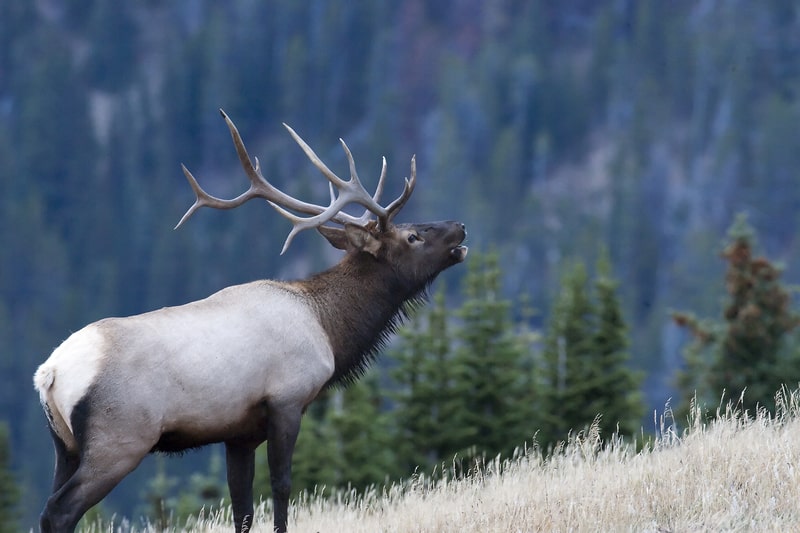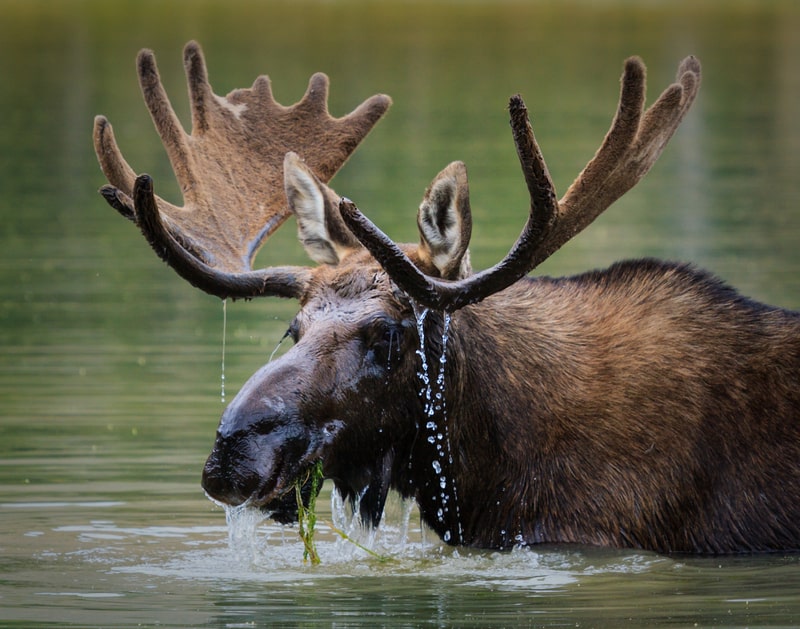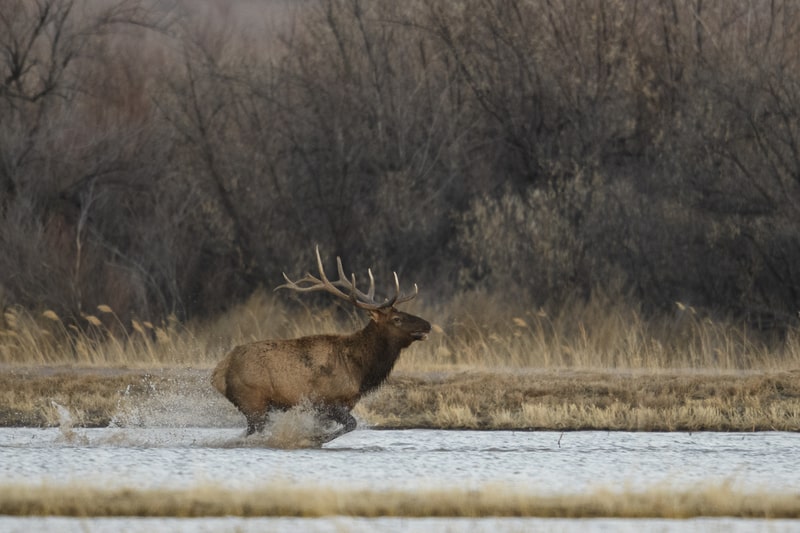Last updated on December 25th, 2022
The elk is an impressive sight. Its regal bearing and stately crown have fascinated humans for thousands of years. Kings and nobles sought them out as prized additions to their collections. Healers used elk as sources of natural medicine, artists leaned on them for inspiration, and natives weaved them into their daily lives. The peaceful animal is a boon to its environment wherever it goes, and its benefits helped it spread across many countries. Read on to learn 40 interesting facts about elk.
Elk Basics
1. What’s in a Name?
People call the elk by different names. For biologists, it is the Cervus Canadensis. For indigenous peoples like the Shawnee and Cree, it is the wapiti which means white rump — a reference to the light patch of hair on their brown body.

2. One Big Happy Deer Family
The elk belongs to a big family of hoofed ruminants called Cervidae. It is related to the white-tailed deer, the pudu, the caribou, and the moose.
3. Towering Height
Elks appear taller than they are. Most only reach 4 to 5 feet from the ground to shoulder. However, their antlers can shoot up another 4 feet above the head, making them look like nine-foot giants.
4. Loud and Proud
Elks have a distinctive high-pitched roar. The males use it to attract mates and tell others about their territories. Its fundamental frequency can go above 2 kHz — way higher than that of a human child at 0.3 kHz.

5. Elk vs. Moose
Are you confused about these two? Look at their antlers. These are long and pointed on the elk but wide and flat on the moose. The smaller elk also like to travel in large herds, whereas the large moose are solitary creatures.
6. Bolder in the Cold
Elks will rise when temperatures drop. Expect to see more of them roaming in the fall and winter. Even during summer, they forage early in the mornings and later in the evenings to avoid the heat.
7. Life Expectancy
Many animals live longer in captivity, but elks are an exception. Leave them in the wild, and they will thrive for about 26.8 years. Put them in a zoo, and you can expect them to last 24.7 years on average.

8. Savvy Sprinters
They may be heavy, but they are fast. Elks can outrun horses in short sprints and go on 40 mph romps to evade predators. They can even jump as high as eight feet.
Origins and Evolution
9. Ancient Origins
According to fossil records, elk ancestors appeared 25 million years ago in Eurasia. Their population exploded when the ancient ocean called Tethys disappeared and gave way to vast grasslands, providing them with abundant food.
10. Genetic Supremacy
Antlers signal genetic quality. Studies show that males that grow large antlers relative to their body size have better resistance to pathogens. They also have higher sperm production for greater reproductive capacity.
11. Giant Elk
The most massive antlers ever? Those belong to the extinct Irish elk or Megaloceros giganteus. They measure 12 feet across and weigh nearly 90 pounds — great for impressing the females.

12. Pointed Weapons
Elks are vulnerable in the wild. In Yellowstone National Park, predators like wolves may hunt them down. Their antlers evolved as defensive weapons to discourage predation. Males sometimes spar to practice and establish dominance.
Elk Conservation
13. Elk Recovery
Less than five elks remaining? It happened in 1875 for the Californian subspecies called tule elk. The Department of Natural Resources and private citizens implemented strict protection measures to help them recover. The population bounced to 3,900 by 2010.
14. Conservation Status
The worst is over for the elks. The International Union of Conservation of Nature no longer considers it endangered. There are over 750,000 across the US and Canada, with a steady positive trend for the population.
15. Ecosystem Management
National parks reintroduced elk to balance ecosystems. They prevent plant overgrowth through their diet and serve as prey for large predators. Only 60% of attempts were successful, but that was enough to stabilize their population in North America.
16. Elk Habitat
Do you want to see wild elks? They roam a vast area from the Eastern Rockies to New Mexico. You will find them in woodlands, open mountains, aspen-hardwood forests, and coniferous swamps.
Elk Reproduction

17. Male Privilege
Only male elks have antlers. They weaponize these when competing for mates, with rivals knocking each other out to impress the females. These grow in the spring and shed in winter, so they have a fresh pair each year.
18. Gestation
After mating, female elks will carry their baby in their wombs for six months. They only have one calf at a time, allowing them to focus on its upbringing. Babies weigh 31-35 pounds at birth.
19. Hide and Seek
A newborn elk can stand up within minutes, yet it spends most of its first 16 days lying motionless. Mothers give birth in secluded areas to hide their babies from predators, usually behind tall grass or shrubs.

20. Calf Growth
A calf will take its sweet time with its mother. After their initial bonding, it is ready to join the herd. Elks rapidly achieve independence, with most of them weaned within sixty days.
21. Life Cycle
By the time they reach 16 months, elks are ready to mate. They will continue to produce offspring until the end of their lives at eight to twelve years old. A few live until their twenties.
22. A Rapid Rate
Elk antlers are fast-growing bones. They can get up to an inch longer every day. Those who bathe in sunlight tend to have higher testosterone levels and faster growth. A full-grown male can carry 40-pound antlers.
23. More is Better
It is all about the numbers. When selecting mates, females go for males with more antler points. It seems that they can count with high accuracy. They choose mates with 10 points over those with 9.
24. Elk Signs
Some people scratch tree bark to leave their names. Elks do something similar, rubbing their antlers against trees. If you see these scratches, you are hot on the elk trail. It also polishes the bone and makes it more attractive for the ladies.
25. Stench Snare
Peeing to attract potential mates is nothing new. However, elks take it to another level by digging a hole, filling it with urine, and bathing in the liquid. Well, their stench will surely be hard to miss.
Interesting Behaviors

26. Hungry Herbivores
Elks love plants. They eat grasses, violets, dandelions, clovers, hawkweeds, and mushrooms whenever available. In the winter, they dine on pine, cedar, and maple. This high-fiber diet is hard to digest, so they regurgitate and re-chew to help their tummies break things down.
27. Elk Bugle
It did not make sense. The voice box of an elk is not compatible with the high-pitched sound. So how do they produce it? It turns out that they move their lips and nostrils simultaneously. Males can roar and whistle at the same time.
28. Footloose
Elk bugling works for long-distance communication. Others can hear it from miles away. How about short distances? Scientists think they may be using their anklebones for signaling as they walk. These produce cracking and popping noises.
29. Elk Etiquette
When visiting a wildlife refuge, visitors should keep their distance from elks. People can spook them, making them change their behavior. It is best to stick to designated trails and use binoculars.
30. Elk Imitation
Elk bugle is fascinating. Some people cannot help but imitate it to get the animal’s attention, but you should not do this. It may irritate or threaten the males during the mating season. You could be putting yourself in danger.
31. Social Animals
Elk herds are massive. Some can reach thousands of members, like the 11,000-strong Jackson Elk Herd. The members are segregated by gender but always controlled by a single female. It is the matriarch that runs the show.

. . . continue reading on the next page
